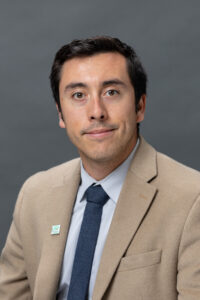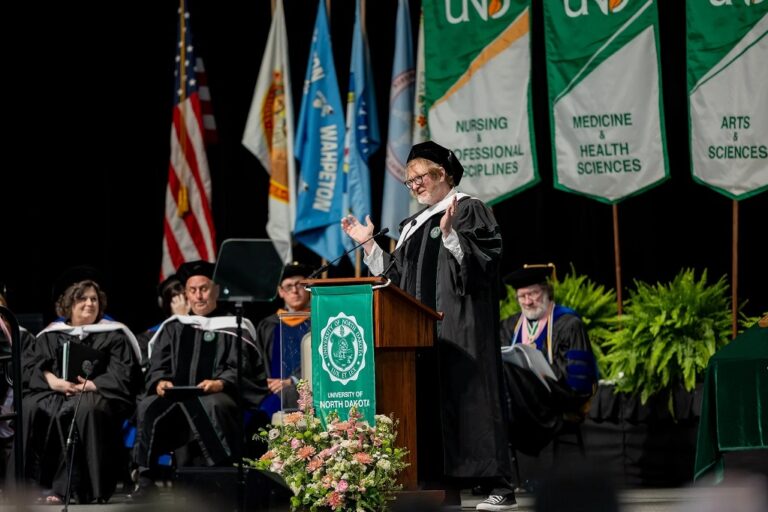Pinning the tail on wildlife art
Paur Lecture at UND features Chuck Black, ’10, whose Northern Pintail Duck painting won the 2023 Federal Duck Stamp Art Contest

For Chuck Black, a UND alum and wildlife artist, the 10th time was the charm when it came to winning the Federal Duck Stamp Art Contest.
Black, who graduated in 2010 with a degree in Wildlife Biology, delivered the 2024 Paur Lecture last month. The talk is given in honor of Glenn Allen Paur, a native of Pisek, N.D., who graduated with a fisheries and wildlife management degree from UND, served as president of the Fisheries & Wildlife Biology Club and was a member of the Wildlife Society.
Tragically, just days after graduating in 1978, Paur died in a boating accident on Leech Lake, Minn., while helping a UND professor conduct research.
Black’s oil painting of a Northern Pintail Duck won him the 2023 edition of the Federal Duck Stamp Art Contest. His painting will be made into the 2024-25 Federal Migratory Bird Hunting and Conservation Stamp, or “duck stamp” for short.
Sales of the $25 stamp, required of all waterfowl hunters nationwide, fund wetland protection to the tune of $40 million a year.

A love of the outdoors
Black’s passion for conservation and wildlife art was born out of a childhood spent exploring the great outdoors. He has especially fond memories of canoe trips to the Boundary Waters of Northern Minnesota and Ontario.
“My parents had me out on the water or in the outdoors every chance they got,” he said. “This is what I knew from the start — it’s where the passion behind everything I love about the outdoors began.”
The Stillwater, Minn., native said he often became restless when in school and used art as an outlet to connect with the natural world while stuck inside.
“If I’m being honest, I absolutely hated school,” he said. “I wanted to be outside because it’s all I ever knew, and then I got to the age where I had to sit in a room — and it was really hard for me. Artwork was my way to escape all that.”
Black also cited the famed wildlife illustrator from South Dakota, Terry Redlin, as a significant influence.
“Aside from my parents, he was my childhood hero,” he said. “I would get my hair cut at a barbershop in the local shopping mall, and next door was a print gallery that was like 70% Terry Redlin, with all his prints scattered across the walls. As soon as I was finished, I’d run next door and stand there with my mouth wide open and immerse myself in it.”
Despite his dislike of school, Black harnessed his passion for the outdoors and turned it into studying wildlife biology at UND.
After graduation, Black worked several jobs with conservation agencies, including elk management at Theodore Roosevelt National Park, sage grouse research in Montana, tracking mule deer movement with Colorado Parks and Wildlife and wild hog management at Great Smoky Mountains National Park in North Carolina and Tennessee.

Maturing as an artist
Black eventually returned to Theodore Roosevelt National Park as a bat technician — a job that required him to observe the entrance to a cave for bats for upwards of six hours at a time. Luckily, the job’s sheer monotony proved to be a turning point in Black’s artistic career.
“I never did see a bat,” he joked. “As things got going, though, I got permission to work on artwork while I was sitting in front of the cave. This is where my artwork started to take a turn for the better. I started to think about my relationship with the outdoors more. Painting outside is one of the most difficult things; it really takes you out of your comfort zone and throws you into the fire pit.”
In addition to honing his own craft and expanding into mediums such as acrylic painting, Black began studying the way other wildlife artists orient their pieces. This led him to, among other things, the Fibonacci Sequence. The mathematical sequence — so named for the Italian mathematician who invented it in the 13th century — starts at zero, with each new number comprising the sum of the two previous ones.
Also called the golden ratio, the Fibonacci Sequence is used by artists due to its presence in natural objects such as flowers, shells and the human face. In particular, the pattern of the numbers can be used to create a spiral.
Using this knowledge and experience, Black placed first in the 2013 Colorado Waterfowl Stamp Competition with an acrylic painting, an award he considers his “first big accomplishment as an artist.”
Despite this success with acrylics, Black said the limitations of the medium led him to pursue oil painting. He found success with oils two years later, winning the 2015 California Duck Stamp Competition.
“To this day, that’s what attracts me to artwork — the endless possibilities,” he said. “Learning new things is always my interest. It’s not necessarily producing one result.”
As he became more proficient with oils, Black began painting on location outdoors, which led him to the subject of his 2023 award. When the competition announced the Northern Pintail as an eligible species for entry, Paur said it was a challenge he couldn’t pass up.
“I felt like every painting leading up to my duck stamp last year was preparation and education for myself,” he said. “Even though I love every piece of artwork I do, I had an experiment in mind I wanted to conduct.”
Black spent countless hours taking photo and video of a male pintail or drake, waiting in a marsh for a hen. The painting — Black’s 10th entry in the Federal Duck Stamp Competition — beat out 200 others for the award, something he said he is “still trying to believe today.”
The future of conservation storytelling
Black said his desire to preserve and tell our species’ story is an age-old tradition.
“Conserving our stories can serve as the backbone of our various beliefs, values and discoveries,” he said. “It doesn’t just have to be natural resource conservation. It can be religious or community conservation. To me, anything that’s important to you is what conservation storytelling represents.”
Black added that winning the competition is an honor he feels comes with the responsibility to further conservation through his art.
“I feel that a lot more eyes and attention are on myself and my work,” he said. “I want to now take my work a little more seriously than running experiments and trying to teach myself. This is where I hope to step into the work of my life as an artist.”
Regarding the impact of artificial intelligence on art, Black expressed confidence that the appetite for human storytelling will prevail.
“I’m not the least bit concerned about it,” he said. “No matter how much this technology or any technology advances — you could go to the point where you have physical robots making the paintings themselves — I don’t think anything will ever be able to replace your own story. Your experiences and discoveries along the way, that’s what we connect with when it comes to our communities. We always will share a passion over similar things — we as a species are storytellers.”
Paur’s sisters attended the lecture and presented Nicholas Rush, a UND Fisheries & Wildlife student, with the Glenn Allen Paur Memorial Scholarship. The $1,000 scholarship is awarded to a junior or senior studying biology.




